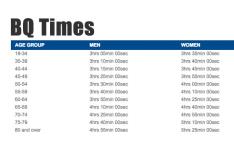
Growing up, I remember my mom working hard to clean the house before the housekeeper came to clean the house. Yep, she cleaned before the housekeeper did. She didn't want anyone to come into a dirty house. I can understand the logic, but it kind of defeated the purpose of the housekeeper. Well, it goes without saying, we didn't keep housekeepers for very long. We laugh about it now when we get together as a family and reminisce.
Many runners have a similar syndrome. I call it "Cart-Before-the-Horse-itis." I've worked with a few who have experienced the syndrome. They'll complain about this pain or that. This injury or that. I'm thinking to myself, "Your marathon training doesn't kick in until two or three months down the road. What are you doing to feel like this?"
With a little probing, I discover that they're doing self-prescribed hard runs (speed work and long runs). When I probe a little deeper, I discover that they're doing this in order to see what they're capable of doing before their training officially kicks in. It's a confidence thing. They want to know they can handle the workouts before they do the workouts.
The problem is without a proper base and proper progression of increased intensity over the period of the "real" training plan, these runners increase their chances of injury exponentially, not to mention the head games that can occur this early in the game.
More: Avoid a Running Injury With the 10 Percent Rule
Why Marathon Training Requires Phases
Between major endurance races, like a spring and a fall marathon, runners shouldn't be doing intense speed work like intervals, hill repeats and tempo runs. Nor should they be doing extremely long runs or logging high-mileage weeks before official training begins.
More: 6 Ways to Copy the Offseason Breaks of Elite Runners
Running is not unlike other sports that have periodization or "seasons." Like football, soccer, basketball, or hockey, there's a preseason, in-season, post-season and offseason to running.
If you recently ran or are about to run a spring marathon, and you plan to run a fall marathon, then it's best to think of yourself in offseason or recovery for about four weeks after that spring race. Take the first week completely off. During weeks two, three and four, you can begin doing some light running but nothing intense (pace or distance). This will give your body time to heal and rebuild from your spring race.
More: 5 Golden Rules of Marathon Recovery
After the fourth week, you can move into your preseason or base-building phase, and start building back your weekly mileage base—but gradually. This will help you condition your body to being back on the road or the trail. During the preseason time, work your total weekly mileage back up to 20 to 25 miles for at least a month prior to the start of your official training.
- 1
- of
- 2
About the Author

Get ACTIVE on the Go


Couch to 5K®
The best way to get new runners off the couch and across the finish line of their first 5K.
Available for iOS | Android







Discuss This Article